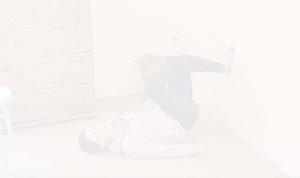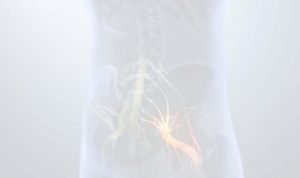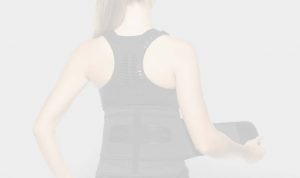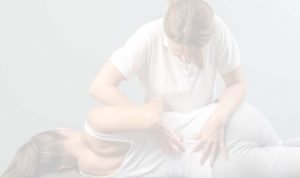You have probably stumbled across this post because you or a family member/friend are suffering with lower back pain and you are wondering if you have the dreaded “slipped disc”. Hopefully I can shed some light onto this very common complaint and maybe help you move forward with your injury.
Firstly, the term “slipped disc” is one I dislike. It is not an accurate description of your injury. I can’t tell you the amount of times a patient has come to my clinic for the first time and said to me ” i’ve got a slipped disc, I’m hoping you can pop it back in” or “i’ve had this slipped disc before, a few years ago, and my last chiropractor put me on my side and manipulated it back in, it’s been fine ever since”. Well, the answer is no I can’t and no they didn’t, and here’s why.
Discs do not slip. They are physically attached to your vertebrae and are going nowhere unless a surgeon removes it for you. A more appropriate term for your injury is a disc herniation or a disc tear. There are several ways in which a disc can be injured and become a source of pain, more on that later. Remember that the severity of the injury will also play a part in how much pain there is, and that your lifestyle, i.e your work life and home life activities will be an important factor for the time it takes to become pain free again. Not all disc injuries are the same and they require different approaches to managing them, so if you have complained about your back pain to a friend and they have told you “that sounds just like what I had” my advice would be to have an assessment with a good clinician to narrow things down a little, because you may need different management to your friend.
Let’s talk anatomy. This is important
A disc is a bit like a jam donut. A very tough jam donut. It is formed by a very strong outer ring consisting of many concentric layers of collagen fibres orientated at different angles. A bit like an onion actually. The differing angles of the fibres allow the disc an immense amount of tensile strength and allow it to offer great resistance in multiple directions.
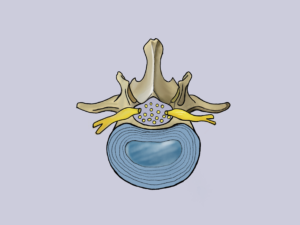
At the centre of the disc is the nucleus. It is a jelly-like substance and offers strength and flexibility to the spine as well as acting as your shock absorber. It is 65%-85% water. It is fluid! and this is why when the outer fibres tear and this material leaks through (herniates) it cannot be “popped” back in with an adjustment.
Interesting and relevant facts for anyone with a disc injury
One of the most interesting things I have always found about the nucleus of a disc is that it has been protected from your immune system since before you finished developing in the womb. It has never been exposed to your immune cells. Your body does not recognise this jelly-like substance as part of you. This is going to be a problem for you if you tear your disc.
Luckily the outer part of the disc is recognised as part of you and is there to protect and contain the nucleus. Your discs are highly pressurised structures and any blood vessels (carrying immune cells) or nerve endings (pain receptors) would collapse under the pressure if they tried to extend into the disc. Only the outer 1/3rd of a disc receives blood supply and has nerve receptors. The down side? when you do have a disc injury, it is usually in the inner 2/3rds of the disc and disc nutrition is poor. This means that healing time is very, very long. Don’t expect to skip out of your chiropractor’s clinic after one session of manipulation if you have a disc injury.
Under pressure
When the disc fibres are torn, the jelly-like nucleus can seep through the layers. Like a puncture in a tyre, the pressure in the disc decreases. If it decreases enough then blood vessels and nerve endings can infiltrate further into the disc. Blood vessels mean immune cells and nerve endings mean pain receptors. So you can see why this is going to be a problem for the nucleus which is not recognised as part of you. Once it is detected by your immune system there is going to be a massive inflammatory reaction, and pain.
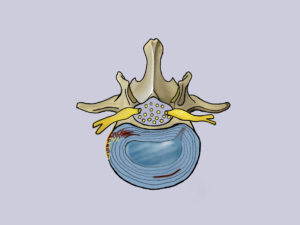
The immune cells over time will “eat up” anything that “shouldn’t be there”, which as far as your killer immune cells are concerned, includes your disc nucleus. When it is done, pain will reduce, but the function of the disc is also now reduced and it will never be the same again. The disc will not regain its pressure and will thereafter offer sub par performance thereafter. The disc becomes the weak link in the chain and will over time cause more strain on adjacent segments. This is why it is often the case that once one disc is injured, somewhere down the line the neighbouring discs also start to fail.
Let’s talk injury?
As I mentioned in the introduction there are different mechanisms of injuring a disc and different pain presentations to go with them.
The first, is the type most associated with nerve root irritation conditions such as sciatica. The annular ring of the disc tears, allowing nuclear material to seep through and a focal bulging of the disc encroaches into the space occupied by the nerve root as it exits the spinal canal.
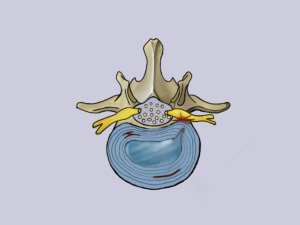
Think of nerve tissue as the spoilt brat of the body. If conditions aren’t just right then it has a hissy fit. By simply touching the nerve the disc can cause irritation. Nerve symptoms may consist of sharp electric pain that shoots from one place to another. Burning pain is also possible as well as pins and needles, numbness, and unusual sensations such as a feeling of water trickling along your skin. With enough nerve compression the muscles that the nerve supplies may also exhibit symptoms. Twitching is possible as well as weakness. Your leg may just give way or you may keep stubbing your feet or tripping over them. The particular muscles affected will depend on which nerve is affected so it is important to have a thorough assessment. Back pain with leg pain does NOT necessarily equal sciatica. This type of disc injury may respond to the Mckenzie protocol often prescribed to those with sciatica, provided the disc still has 70% of its height. This technique will NOT work in a disc that has lost more than 30% of its height due to pressure loss.
Second begins with a tear in the annular ring as well. Again, the nucleus seeps through, making its way toward the back of the disc. But in this instance the nuclear material seeps radially through the collagen layers as well. This type is more likely brought on with repetitive bending and twisting action of the lower back.
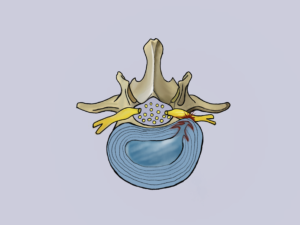
Again the pressure is lost and this makes shearing forces more likely and the disc loses its ability to transfer forces optimally. This type might be common in younger adults and the pain pattern may appear to change. Sometimes it is on the right, sometimes on the left. Transitioning from one position to another may be aggravating activities, such as getting into or out of a chair, rolling over in bed, getting into or out of the car. There is functional instability when the pressure is lost in the disc and consequently too much segmental movement happens when you try to move. Think of this as constantly picking a scab. If you cut your hand but constantly keep picking at it as it tries to heal or keep applying frictional forces across the wound then inflammation and pain will persist. This type of injury is unlikely to respond well to the McKenzie protocol because the nucleus is trapped amongst the layers of the annulus ring. It is more likely to respond with movement retraining and control and the abdominal brace technique, giving the disc chance to heal over time.
The third type is often the case when a person feels a “pop” when their back gives in. They will often tell me “I felt a pop in my back”. In this case it is very likely that the endplate ( the cartilaginous layer between the vertebrae and the disc) fractures. This is likely the ‘pop’ that is felt. As before, this offers an escape route for the nucleus. This time however, the nuclear material seeps vertically through the fractured end plate and into the adjacent bone. Vertebral bone is the 2nd most haemopoetic bone in the body, which means it has a great blood supply. You guessed it; massive inflammatory response, and pain.
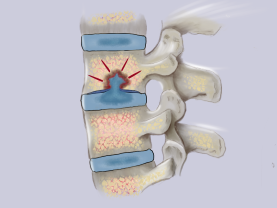
The fourth type is actually the same mechanism as the first I described except that the external layers of the disc actually rupture, allowing the nuclear material to exit the disc entirely.
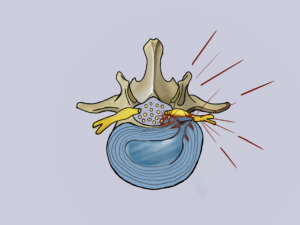
This is called a disc sequestration. Often when this happens the nuclear material leaks out into the spinal canal where there is plenty of nerves to irritate. Depending on which nerves are irritated by the nucleus and the inflammation that surrounds it the pain pattern can vary. I was once caught out by a sequestered disc. A presentation of L4 nerve root compression. When an MRI was done it showed no disc or other structure compressing the L4 nerve root but the L3 disc had ruptured and nuclear material had leaked out and dropped down onto the L4 nerve root causing L4 nerve radiculopathy. I wont be caught out by this again!
So you see, your disc injury may not be the same as your friend or colleagues. Management and time frame will vary depending on how the disc is injured. How many times you aggravate your injury will also be a big factor in the time it will take to be pain free again. If you are a manual labourer that is constantly ‘picking the scab’ of your injury all day every day then your injury will take much longer to heal than someone who is able to make the necessary adaptions to their work and home life to limit the aggravating factors.
Due to the poor nutrition that a disc has, expected healing time of a disc tear is 18-24 months. Don’t panic! This doesn’t mean you will have pain for 18-24 months. With luck and a good chiropractor you could be pain free in a matter of weeks. What this means is that the risk of re-injuring this healing disc is very high and without the pain to remind you of your injury, you will forget. Trust me, you will. One day, you will reach for your car keys without good movement control and core stability and will be suddenly and painfully reminded that your disc is still torn. It is a typical presentation of disc pain patients that they will say ” I get a flare up two or three times a year”. It isn’t a flare up, it is re-injury.
So my parting advice is this. Discs are rarely injured by one single event. They are made of sturdy stuff. Everyone who comes to my clinic with a disc injury was doing something light when their back failed them. This is because discs undergo micro trauma over time from years of poor postural habits and poor movement control. The way you do the most basic of daily tasks is what is damaging your discs and this is what you need to retrain in order to spare your spine. If you believe, or have been told you have a disc injury then “The Back mechanic” written by Stuart McGill is a good place to start. It was written for back pain sufferers and has all you need to conquer your back pain.



